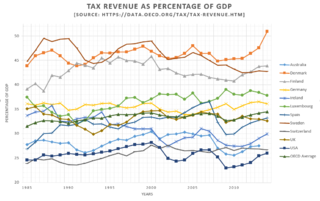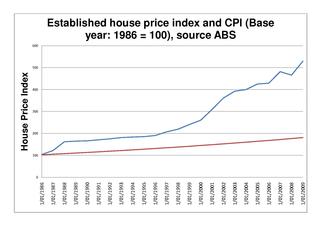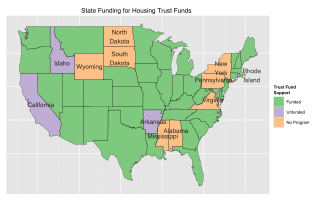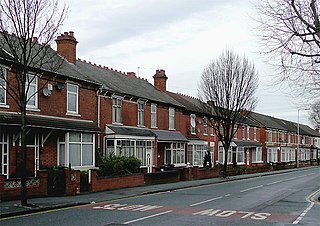Related Research Articles

A consumer price index (CPI) is a price index, the price of a weighted average market basket of consumer goods and services purchased by households. Changes in measured CPI track changes in prices over time.
The Low-Income Housing Tax Credit is a dollar-for-dollar tax credit in the United States for affordable housing investments. It was created under the Tax Reform Act of 1986 (TRA86) and gives incentives for the utilization of private equity in the development of affordable housing aimed at low-income Americans, with affordability restrictions on the properties expiring 15-30 years later. LIHTC accounts for the majority of all newly created affordable rental housing in the United States today. The maximum rent that can be charged for designated affordable units is based on Area Median Income (AMI), and over 50% of residents in LIHTC properties are considered Extremely Low-Income. The credits are also commonly called Section 42 credits in reference to the applicable section of the Internal Revenue Code. The tax credits are more attractive than tax deductions as the credits provide a dollar-for-dollar reduction in a taxpayer's federal income tax, whereas a tax deduction only provides a reduction in taxable income. The "passive loss rules" and similar tax changes made by TRA86 greatly reduced the value of tax credits and deductions to individual taxpayers. Less than 10% of current credit expenditures are claimed by individual investors.
Section 8 of the Housing Act of 1937, often called Section 8, as repeatedly amended, authorizes the payment of rental housing assistance to private landlords on behalf of low-income households in the United States. Fort Lauderdale, Florida Housing Authority Director William H. Lindsey, upon the advice of Housing Authority attorney J. Richard Smith, initially developed 11(b) financing in the early 1970s to accommodate a local savings and loan interested in assisting with urban renewal projects Lindsey eventually brought to fruition. This was the initial impetus for the subsequent development of the now well known Section 8 Program. 68% of total rental assistance in the United States goes to seniors, children, and those with disabilities. The U.S. Department of Housing and Urban Development manages Section 8 programs.

Canada Mortgage and Housing Corporation (CMHC) (SCHL) is Canada's national housing agency, and state-owned mortgage insurer. It was originally established after World War II, to help returning war veterans find housing, and is a wholly-owned Crown Corporation of the Government of Canada. Since then, it has seen its mandate expand to the mandate of improving access to housing, including owned and rental.

Public housing in Hong Kong is a set of mass housing programmes through which the Government of Hong Kong provides affordable housing for lower-income residents. It is a major component of housing in Hong Kong, with nearly half of the population now residing in some form of public housing. The public housing policy dates to 1954, after a fire in Shek Kip Mei destroyed thousands of shanty homes and prompted the government to begin constructing homes for the poor.
Housing Benefit is a means-tested social security benefit in the United Kingdom that is intended to help meet housing costs for rented accommodation. It is the second biggest item in the Department for Work and Pensions' budget after the state pension, totalling £23.8 billion in 2013–14.
Local Housing Allowance (LHA) was introduced by the government of the United Kingdom on 7 April 2008 to provide Housing Benefit entitlement for tenants renting private-sector accommodation in England, Scotland and Wales. The LHA system introduced significant changes to the way Housing Benefit (HB) levels are restricted and how benefit is paid. It did not replace Housing Benefit - it is just a different way of calculating entitlement under the existing Housing Benefit scheme: the Local Housing Allowance is based on the 30th percentile of local rented accommodation, while the 50th percentile or median was used from the introduction of the policy until 2011. LHA rates relate to the area in which the housing-benefit claim is made. These areas are called "Broad Rental Market Areas", defined as "where a person could reasonably be expected to live taking into account access to facilities and services", and a selection of rents in the area are used to determine the LHA for each category of housing in the area.
Income tax in Australia is imposed by the federal government on the taxable income of individuals and corporations. State governments have not imposed income taxes since World War II. On individuals, income tax is levied at progressive rates, and at one of two rates for corporations. The income of partnerships and trusts is not taxed directly, but is taxed on its distribution to the partners or beneficiaries. Income tax is the most important source of revenue for government within the Australian taxation system. Income tax is collected on behalf of the federal government by the Australian Taxation Office.

Affordable housing is housing which is deemed affordable to those with a household income at or below the median as rated by the national government or a local government by a recognized housing affordability index. Most of the literature on affordable housing refers to mortgages and a number of forms that exist along a continuum – from emergency homeless shelters, to transitional housing, to non-market rental, to formal and informal rental, indigenous housing, and ending with affordable home ownership.

Income taxes are the most significant form of taxation in Australia, and collected by the federal government through the Australian Taxation Office. Australian GST revenue is collected by the Federal government, and then paid to the states under a distribution formula determined by the Commonwealth Grants Commission.

The Australian property bubble is the economic theory that the Australian property market has become or is becoming significantly overpriced and due for a significant downturn. Since the early 2010s, various commentators, including one Treasury official, have claimed the Australian property market is in a significant bubble.

Housing in the state of Victoria, Australia is characterised by high rates of private housing ownership, minimal and lack of public housing and high demand for, and largely unaffordable, rental housing. Outside of Melbourne, home to 70% of the state's population, housing and rent is more affordable. In Melbourne, access to public housing is generally better, but housing and rent are less affordable.
My Home Purchase Plan is one of the public housing initiatives of Hong Kong. This plan enables eligible citizens to purchase homes by way of "rent-and-buy". The Plan aims to provide assistance to potential sandwich class home buyers who are able to repay mortgages in the long term but currently do not have enough savings for the down payment. This plan is introduced by the Chief Executive of Hong Kong in the Policy address of Hong Kong 2010. The implementation of plan, that is the first 5000 flats under the plan is expected to be ready for sell in 2014.

Housing trust funds are established sources of funding for affordable housing construction and other related purposes created by governments in the United States (U.S.). Housing Trust Funds (HTF) began as a way of funding affordable housing in the late 1970s. Since then, elected government officials from all levels of government in the U.S. have established housing trust funds to support the construction, acquisition, and preservation of affordable housing and related services to meet the housing needs of low-income households. Ideally, HTFs are funded through dedicated revenues like real estate transfer taxes or document recording fees to ensure a steady stream of funding rather than being dependent on regular budget processes. As of 2016, 400 state, local and county trust funds existed across the U.S.
The continuum of affordable housing in Canada includes market, non-market, and government-subsidized housing.

Howard County Housing is the umbrella organization for the Howard County Department of Housing and Community Development and the Howard County Housing Commission. The Department is Howard County Government’s housing agency, and the Commission is a public housing authority and non-profit. Both have boards that meet monthly.

Housing in the United Kingdom represents the largest non-financial asset class in the UK; its overall net value passed the £5 trillion mark in 2014. About 30% of homes are owned outright by their occupants, and a further 40% are owner-occupied on a mortgage. About 18% are social housing of some kind, and the remaining 12% are privately rented.

Affordable housing is housing that is deemed affordable to those with a median household income as rated by the national government or a local government by a recognized housing affordability index. A general rule is no more than 30% of gross monthly income should be spent on housing, to be considered affordable for the challenges of promoting affordable housing varies by location.
Community housing in Australia is not-for-profit affordable housing provided by community housing organisations known as Community Housing Providers (CHPs). These organisations have varying modes of operation and structure, and different types of stock. Any budget surplus in CHPs must be used to maintain existing housing, to provide better services for tenants or to help finance new properties. Although independent, the CHPs are regulated by the state, and commonly receive public funding. Most of their stock is owned by public housing authorities (SHAs) in each State, and the CHPs manage the tenancies using the rent received from tenants.
Judith Nancy Yates was an Australian housing economist. She was a lecturer and associate professor at the University of Sydney from 1971 to 2009. As a social liberal economist, she published over 120 papers in academic journals and government and industry reports on most aspects of Australia's housing sector, most notably on distributional aspects of the tax and finance system, on affordability and the supply of low-rent housing.Throughout her career she was appointed to a number of government advisory committees, and she contributed to many government inquiries.
References
- ↑ Australian Department of Social Services. "National Rental Affordability Scheme".
- 1 2 "'Eye-watering': Map shows big housing issue". The West Australian. 6 October 2021. Retrieved 26 April 2022.
- ↑ NSW Department of Planning & Environment. "Affordable Rental Housing (SEPP)".
- ↑ "House price rises to weather rate hikes: report". The Sydney Morning Herald. 29 January 2010.
- ↑ Australian Department of Social Services (15 May 2015). "National Rental Affordability Scheme".
- ↑ "NRAS Tax Free Incentive Payments for Investors". Affinity Property. Retrieved 8 November 2021.
- 1 2 Australian Attorney Generals Department (2008). "National Rental Affordability Scheme Prospectus" (PDF).
- ↑ "Gillard announces levy to pay for flood damage". 27 January 2011.
- ↑ "NBN tops levy as legislative priority". The Australian. 2 February 2011.
- ↑ "Senate debates, Questions Without Notice". 23 June 2011.